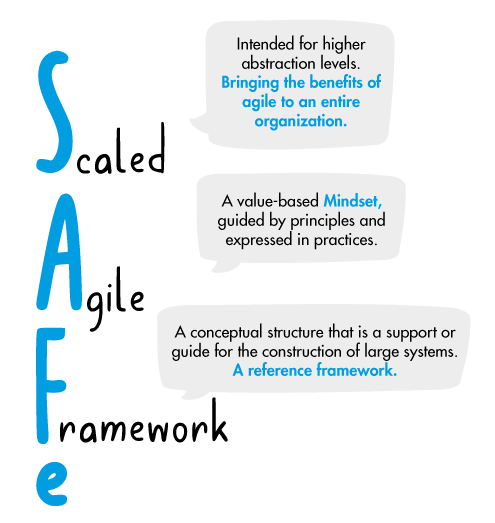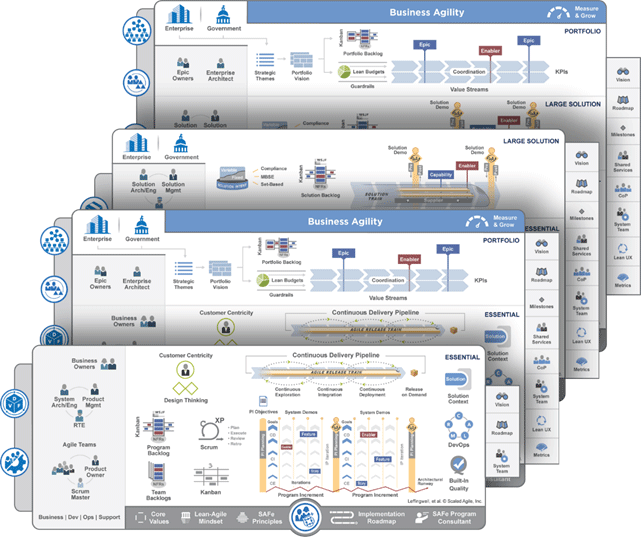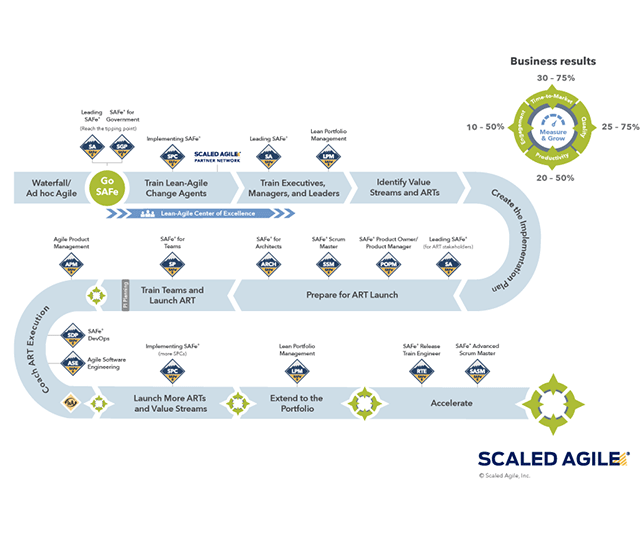What is Scaled Agile Framework (SAFe®)?
Scaled Agile Framework® is a knowledge base for adopting agile work methods in large organizations.

"Better software and systems make the world a better place."
- © Scaled Agile, Inc.
Scaled Agile Framework graphically presents a management model to scale the application of agile practices from a team to program management, and from program management to the entire organization. More specifically, SAFe® for Lean Enterprises (the latest iteration) is a knowledge base of proven, integrated principles, practices, and competencies for achieving business agility using Lean, Agile, and DevOps.
Its knowledge base of techniques, patterns, and models has been successful in the construction of software in the Lean-Agile environment. Its graphic structure provides a logical and coherent presentation that is regularly updated and includes:

© Scaled Agile, Inc.
The Big Picture
SAFe can be implemented using four out-of-the-box configurations: Essential, Large Solution, Portfolio, and Full.

© Scaled Agile, Inc.
Implementation Roadmap
The Roadmap provides a success path made up of critical moves.

© Scaled Agile, Inc.
House of Lean
The shift from a Fixed Mindset to a Growth Mindset that is essential to SAFe is based on these Lean Thinking principles and practices.
What makes Scale Agile Framework SAFe?
In 2010, the creator of SAFe, Dean Leffingwell, recognized that the Scrum methodology worked great for small teams who were delivering software that was prioritized in the team backlog (and it still does today). However, enterprises that were trying to manage a large number of teams in a coordinated way to deliver Programs or Large Solutions needed a solution to scale the success of team-level agility.
Scaling agile beyond several teams can get messy, quickly! How does everyone know what everyone else is working on? What dependencies exist between teams, programs, and portfolios? SAFe provides a framework that allows enterprises to accomplish strategic objectives. It helps to align these objectives by emphasizing its four core values: alignment, transparency, built-in quality, and program execution.
10 Lean-Agile Principles
Take an economic view
Deliver early and often to provide value incrementally
Apply systems thinking
Optimize the full value stream
Assume variability; preserve options
Uncertainty is certain so apply a set-based approach
Build incrementally with fast, integrated learning cycles
The shorter the cycle, the faster the learning – Plan. Do. Check. Adjust.
Base milestones on objective evaluation of working systems
Use Programmatic Milestones instead of Phase-Gate Milestones
Visualize and limit WIP, reduce batch sizes, and manage queue length
Increase understanding through visual tools to lower total cost
Apply cadence; synchronize with cross-domain planning
Cadence without synchronization isn’t enough; synchronization assures deliverability
Unlock the intrinsic motivation of knowledge workers
Harness autonomy, mastery, and purpose
Decentralize decision‑making
Empower others to make decisions about change
Organize around value
Connect silos by organizing around the flow of value
12 Implementation Steps
No two organization’s paths to agility are the same. The same can be said for adopting SAFe. However, the SAFe Implementation Roadmap provides a success path made up of critical moves. This path was created based on common patterns seen in successful large implementations. It is designed as a guide to drive the changes needed to deliver results. Its 12 steps include:
Reaching the Tipping Point
Train Lean-Agile Change Agents
Train Executives, Managers, and Leaders
Create a Lean-Agile Center of Excellence
Identify Value Streams and ARTs
Create the Implementation Plan
Prepare for ART Launch
Train Teams and Launch the ART
Coach ART Execution
Launch More ARTs and Value Streams
Extend to the Portfolio
Accelerate
Not everyone will go through each step, and not everyone will experience their implementation in this order. However, the most important step is the need for organizations to perceive and plan their goals. They need to be clear and definitive to help form a solid vision.
4 Configuration Levels of Scaled Agile Framework
A growth mindset is at the foundation of all levels of a SAFe implementation, but what about the levels themselves? What implementation is right for your organization?
- Essential SAFe is for organizations who have one coordinated program. Although not a definitive measure, organizations implementing Essential SAFe typically have between 5 and 12 teams. Of note, organizations that have less than 5 teams should be able to accomplish their goals using Scrum of Scrum and don’t require a SAFe solution.
- Large Solution SAFe is recommended for organizations that need to coordinate multiple ARTs.
- The Portfolio level of SAFe is for large organizations that want to focus on business agility. This goes beyond just coordination of technical teams working in an agile way and incorporates everyone in the business. No matter the department, everyone will have a common way of defining business cases and new opportunities that is based on Epics.
- Full SAFe is anyone implementing all 3 levels. If an organization doesn’t require the Enterprise Solution Delivery competency that is part of a Large SAFe implementation, they may choose to only adopt Essential and Portfolio SAFe.
These four configuration levels allow an organization to adapt SAFe to their needs, according to their size and the number and complexity of the solutions they develop. To further help determine which level of SAFe is right for you, see the table below mapping the core competency elements.

Get SAFe Certified
Netmind became the first accredited company to advise and train organizations on the adoption of SAFe® in the Spanish language and, in May 2016, we were the first Spanish company accredited as official partners of Scaled Agile Framework, creators of SAFe®. Our instructors have trained over 850 students in SAFe courses.
As a Silver Partner, we are accredited to deliver a full portfolio of SAFe courses. Each course provides the knowledge needed for a student to pass the applicable exam.